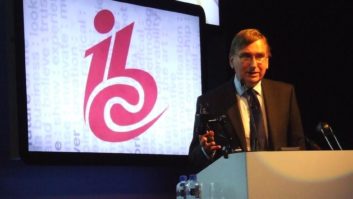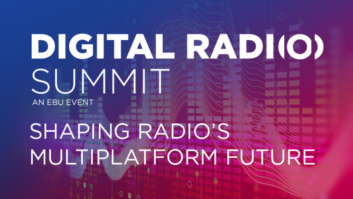
Tomas Granryd of Swedish Radio (L) With Rüdiger Malfeld of Westdeutscher Rundfunk at the EBU Media Lunchtime Talks Meeting in Brussels GENEVA — The European Broadcasting Union promoted the power of radio for World Radio Day 2014 by taking part in three initiatives.
For the special day, the organization arranged a concert featuring Dvořák and Mahler symphonies that was distributed to eight of its member broadcasters through the EuroRadio file exchange system. It also co-organized, along with Radio France, UNESCO and the Union Radiophonique et Télévisuelle Internationale (URTI), a reception and live classical music concert, which took place in Paris.
THREE INITIATIVES
At the EBU Brussels office, the organization hosted a lunch debate entitled “Media Lunchtime Talks” about the latest radio technologies, giving examples of how broadcasters are renewing their relationship with younger audiences. Discussions revolved around how the combination of free-to-air broadcast reception and broadband available in hybrid devices foster new ways of interacting with audiences and personalizing content.
“We have to be everywhere, on every platform, interacting with everyone,” said Tomas Granryd, Swedish Radio P3 channel manager. Granryd emphasized that radio players on the Internet (streaming radio, podcasts and Web portals) as well as social media networks allow broadcasters to get closer to audiences and personalize the listener experience. Social media allows listeners to interact directly with the DJ, but he warns that it’s important to remember “first and foremost radio is about sound, simplicity, free and easy access. Don’t overcomplicate things, radio is easy — think sound, and it will be ok.”

Rüdiger Malfeld of Westdeutscher Rundfunk speaks at the EBU Media Lunchtime Talks gathering in Brussels. During Media Lunchtime Talks, Westdeutscher Rundfunk (WDR) Project Coordinator Rüdiger Malfeld described the advent of what he calls the “Swiss army knife” of media — the smartphone. “The story is about transforming radio from the old world to the new world of smart phones. The seamless integration of Web links in the DAB+ standard broadcast signal makes it possible for listeners to share music, get listening recommendations and interact,” he said.
INTERACTIVITY
“Hybrid radio also means enhanced and personalized news, traffic information and weather available on demand at no additional cost,” said Malfeld. Terrestrial broadcasting is still fundamental for radio in the digital world. It works in synergy with broadband to give users a seamless experience.”
EBU Media Director Annika Nyberg Frankenhaeuser said that radio has proven itself to be a resilient media and remains to be one of the most accessed and trusted sources of information in the digital age.
“Radio has adapted to include new services and ensure access through mobile devices such as smartphones and tablets. This — hybrid — combination of broadcast and broadband in particular makes it possible to develop new ways of being getting even closer to the audience,” she said. “Today, radio reaches more than 80 percent of the European population on a weekly basis, and with average daily listening time in Europe still strong, terrestrial radio is forecast to remain the main platform to access audio content in the foreseeable future.”

The Studios of Polskie Radio’s Czwórka Station As part of its World Radio Day festivities, the EBU endorsed, via its website, three public service broadcasters, which are making a significant effort to raise their appeal among young people — who today represent a small part of radio listeners but will eventually play a big role in radio’s future.
These include Bayerishcher Rundfunk’s Radio PULS, which targets 18 to 29 year olds and makes use of a specific mobile application; Polskie Radio’s Czwórka, which focuses on 15 to 30 year old students via a non-linear approach to broadcasting; and Radio France’s HYPERLINK Le Mouv’. The latter targets 20 to 35 year olds and implements a “reverse broadcasting service,” strategy, where short duration content is produced first for the Internet and then later broadcast.
Davide Moro reports on the industry for Radio World from Bergamo, Italy.










